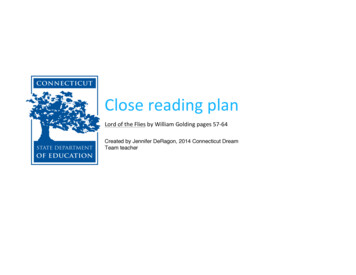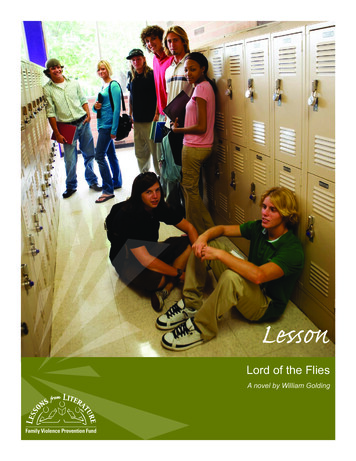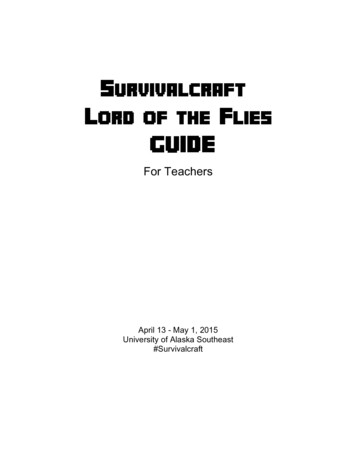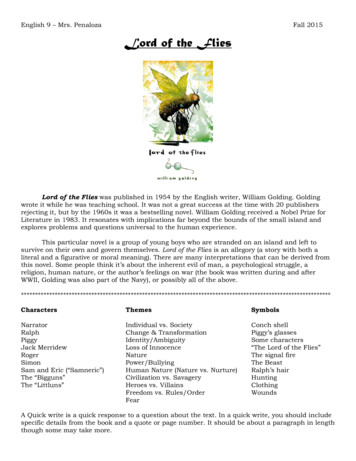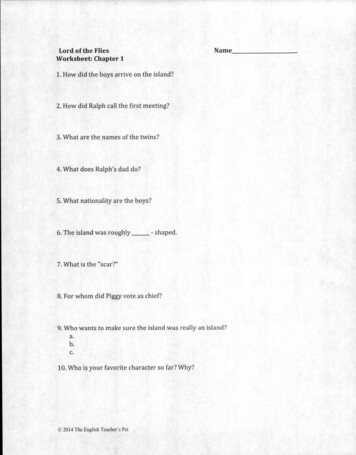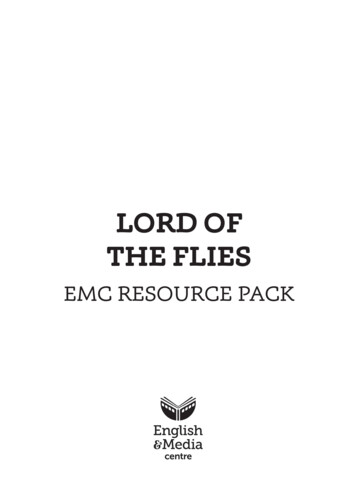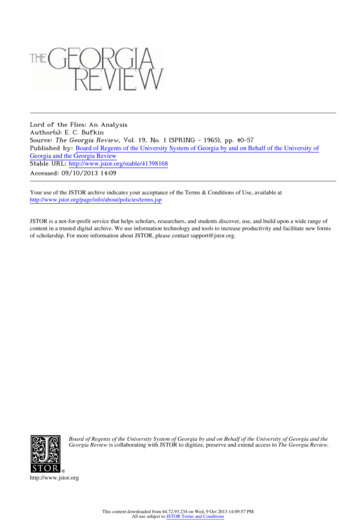
Transcription
Lord of the Flies: An AnalysisAuthor(s): E. C. BufkinSource: The Georgia Review, Vol. 19, No. 1 (SPRING - 1965), pp. 40-57Published by: Board of Regents of the University System of Georgia by and on Behalf of the University ofGeorgia and the Georgia ReviewStable URL: http://www.jstor.org/stable/41398168 .Accessed: 09/10/2013 14:09Your use of the JSTOR archive indicates your acceptance of the Terms & Conditions of Use, available at ms.jsp.JSTOR is a not-for-profit service that helps scholars, researchers, and students discover, use, and build upon a wide range ofcontent in a trusted digital archive. We use information technology and tools to increase productivity and facilitate new formsof scholarship. For more information about JSTOR, please contact support@jstor.org.Board of Regents of the University System of Georgia by and on Behalf of the University of Georgia and theGeorgia Review is collaborating with JSTOR to digitize, preserve and extend access to The Georgia Review.http://www.jstor.orgThis content downloaded from 64.72.93.234 on Wed, 9 Oct 2013 14:09:57 PMAll use subject to JSTOR Terms and Conditions
LordoftheFlies:AnAnalysisBy E. C. BufkinGolding's Lord of the Flies is about evil; and it recounts a quest for order amidst the disorder that evil causes.WILLIAMGolding has said that the theme of the novel "is an attempt to tracethe defects of society back to the defects of human nature. The moralis that the shape of a society must depend on the ethical nature ofthe individual and not on any political system however apparentlylogical or respectable." Theme and moral are worked out throughan adaptation of the Christian myth of the Fall of Man, which hasbeen overlaid with what may be termed the myth of the desert island.Since Golding is a serious student of Greek, and has stated thatEuripides is one of his literary influences, it is not surprisingthat inLord of the Flies the principal technical device he uses is irony.It, like the myth of fallen man, permeates the novel. The presence ofthe myth has been duly noted by critics but, though commentatorshave perceived and incidentally remarked on a wide variety of ironiesin the novel, almost none, with the notable exception of John Peter,has so far recognized that Lord of the Flies, piercing through illusionand appearance to truth and reality, is essèntially an ironical novel.Recognition of this is basic to any analysis of the work, providingas it does the key to both the author's development of theme and hishandling of his subject-matter.Indeed, of two of the major literaryinfluences on Lord of the Flies,one, R. M. Ballantyne's adventure story The Coral Island, serves achiefly ironical purpose. The exact nature of that influence has beenestablished by Golding himself in an interview with Frank Kermode.Asked whether his novel is not a "kind of black mass version ofBallantyne," Golding replied that it is not: "I think," he said, "it is,in fact, a realistic view of the Ballantyne situation." When furtherasked "just how far and how ironically we ought to treat" the connection between the two books, Golding gave an illuminatingreplyabout the origin of his novel:Well, I think,fairlydeeply,but again, not ironicallyin the bad sense,but in almost a compassionatesense. You see, really, I'm gettingat[40]This content downloaded from 64.72.93.234 on Wed, 9 Oct 2013 14:09:57 PMAll use subject to JSTOR Terms and Conditions
LordoftheFlies:ananalysis41myselfin this.What I'm sayingto myselfis "don't be such a fool, yourememberwhen you were a boy, a small boy, how you lived on thatislandwith Ralph and Jack and Peterkin"(who is Simon,by the way,Simon called Peter, you see. It was worked out very carefully inevery possible way[,] this novel). I said to myself finally, "Nowyou are grown up, you are adult,it's taken you a long timeto becomeadult, but now you've got there you can see that people are not likethat;theywould not behave like thatif theywere God-fearingEnglishgentlemen,and they went to an island like that." Their savagerywould not be found in natives on an island. As like as not theywould find savages who were kindly and uncomplicated and thatthe devil would rise out of the intellectualcomplicationsof the threewhitemen on the islanditself.Ballantyne's book, to which Golding refersin this comment,is aboutan "agreeable triumvirate"of boys who are marooned on a coral reefin the South Seas: Ralph, the narratorof the story; Jack, their "king";and Peterkin. Survivors of a "frightful"shipwreck during a "dreadful"storm,they explore the island, which they think must be "the ancientparadise," and, making the best of their situation, lead a happy andorderly life there, hunting hogs, eating fruit, and exploring. "Therewas, indeed," says Ralph, "no note of discord whatever in the symphonywe played togetheron that sweet Coral Island; and I am now persuadedthat this was owing to our having been all tuned to the same key,namely, that of love! Yes, we loved one another with much fervency,while we lived on that island; and, for the matter of that, we loveeach other still." This much of the plot is what Golding used; heneglected the later episodes that deal with pirates and cannibals. Butit was just this much of the plot that must have seemed false, orunrealistic, to Golding.Although neither appreciation nor understanding of Lord of theFlies is dependent upon familiaritywith The Coral Island, the readeracquainted with Ballantyne's work can better see what Goldinghas done in his own novel. The person who knows both stories isaware of the contrast between them, and knows that the contrast is,in effect and purpose, ironical. It resides in the discrepancy betweenthe falseness, or unreality, of his source, as Golding sees it, and thetruth,or reality,of Lord of the Flies. Golding must surely have had thisjuxtaposition in mind, else he would not have so carefully duplicatedin his own novel details from Ballantyne's.This content downloaded from 64.72.93.234 on Wed, 9 Oct 2013 14:09:57 PMAll use subject to JSTOR Terms and Conditions
42THEGEORGIAREVIEWA second major literaryinfluence on Lord of the Flies, an influencethat no critic has noted before, despite its almost glaring presence,is Paradise Lost. The epic and the novel have a common theme, theFall of Man; and it is altogether feasible that Golding, in parallelingin Lord of the Flies situationshighly similar to those in Paradise Lost,meant to enrich and to enlarge, by associative suggestion, the scopeof his narrative.The first of these parallels is the setting. Golding's island, likeMilton's Eden, represents the original earthly paradise where occursthe Fall of Man. That the island is meant to represent this paradiseis easily deduced from the following sentence: "The forest re-echoed;and birds lifted, crying out of the tree-tops, as on that firstmorningages ago." And it is quite possible also that the killing of the sow,to which the boys are "wedded in lust," may itself,since the passageis presented in terms of sexual intercourse, function as a symbolic,parodie re-enactmentof the Original Sin:. . . the sow felland the huntershurledthemselvesat her. This dreadfuleruptionfroman unknown world made her frantic;she squealed andbucked and the air was full of sweat and noise and blood and terror.Roger ran round the heap, proddingwith his spear wheneverpigfleshappeared. Jack was on top of the sow, stabbingdownward with hisknife.Roger found a lodgmentfor his point and began to push tillhe was leaningwith his whole weight.The spear moved forwardinchsquealingbecame a high-pitchedscream.Thenby inch and the terrifiedthroatandthe hot blood spouted over his hands. ThethefoundJacksow collapsed under themand theywere heavy and fulfilledupon her.These two passages may be said to deal with the natural aspectsof the Fall- the natural world and, in it, man. Other passages parallelingincidents in Paradise Lost may be said, in contrast,to be based on thesupernatural.In the one, Golding's boys representthe earliest man andhis Fall in Eden; in the second, they represent the fallen angels, ordevils, and the island is Hell. Golding makes clear that Jack and thechoirboys are devils- fallen angels. Curiously, no critic has commentedon why they are choirboys and not just ordinary schoolboys. Golding,having "worked out very carefully in every possible way this novel,"certainly had a definite purpose in making them so. Even thoughthe concept of angels as singers is both traditional and common,Golding points out the connection between the boys and angelsexplicitly. He says that "ages ago"- a repeated phrase connecting theThis content downloaded from 64.72.93.234 on Wed, 9 Oct 2013 14:09:57 PMAll use subject to JSTOR Terms and Conditions
LordoftheFlies:ananalysis43singing boys and the singing birds of "that first morning"- the boys"had stood in two demure rows and their voices had been the song ofangels." A double irony is at work here. The phrase means that theboys, who are devils, sang like angels and also that they sang songsof angels; that is, liturgie chants which, on the island, undergo pagan"and savage metamorphosisinto Kill the pig! Cut his throat! Kill thepig! Bash him in!" (which Golding terms a "chant" rising "ritually").In Paradise Lost the angels fall from Heaven while war is ragingthere, and Golding has duplicated this situation, too; for the planecarrying the boys is attacked and shot down during a war. In fact,war is the very cause of their being there, just as it is the cause of theangels' fall from Heaven. Thus while the island the boys land on is anemblem of Paradise, it is ironically also an emblem of Hell, completewith the traditional fire (watching which, Piggy "glanced nervouslyinto hell"). And there is also a presiding demoniac god, the Lord ofthe Flies- Beelzebub, the Prince of Devils.Finally, in Lord of the Flies the boys, all of them, assemble, exchangenames (perhaps a parallel to the roll-call of the infernal host), holda council, elect a leader, and explore the island. These are the sameacts, and they occur in the same order, that the fallen angels performin Milton's Hell. Ironically, not Jack, who is "the most obviousleader," but Ralph, who is "no devil," is chosen. But since the movement of the plot is toward the emergence of evil in the boys and itsgradual domination of them, it is, fittingly,not long before Ralph'sposition is usurped by Jack, who finally leads the now savage tribeof boys with their "anonymous devils' faces" and sits in the midstof them "like an idol." (This movement may be viewed, further,asa correspondence to Satan's securing of power in the world.)The story of Lord of the Flies is told from the omniscient pointof view. Golding as narrator shiftsfrom one boy to another, amongthe major characters, telling each one's thoughts and decisions, explaining his motivations and reactions, or seeing a situation with hisperspective; and at the very end he shiftsaway from the boys to theiradult rescuer. Occasionally, at certain crucial times when the contextof the novel calls for an objective, uninvolved voice to be heard asthe voice of truth,Golding stands back from the action and commentsunobtrusivelyon the situation. For the most part, however, the storydevelops through dramatic action and dialogue, not through authorialexposition and comment; and this method contrastswith the moralizingThis content downloaded from 64.72.93.234 on Wed, 9 Oct 2013 14:09:57 PMAll use subject to JSTOR Terms and Conditions
44THEGEORGIAREVIEWfirst-personnarrationof The Coral Island, which Golding is "correcting." He perhaps felt that readers familiar with the Ballantyne storywould be aware of this contrast. Instead of telling, then, Golding isshowing; and the differencein this technique is as significantas thecontrast between the two writers' attitudestoward their material.The omniscient point of view is another device for widening thescope of the novel, for obviously a part of the whole plan of thenarrativeis that the attitudesof each of the four principal charactersRalph, Jack,Piggy, Simon- be included. This particularpoint of viewthe omniscient-is, furthermore,appropriate and importantto the novelin that it can control and unify both what happens on the island andwhat is happening in the world surroundingit. This fictional deviceis capable of producing an over-all irony that another device couldhardly so economically and directly create. The identificationof thedead parachutist, for instance, and the information about where hecomes from and why, would be impossible without the omniscientpoint of view; and the kind of irony that derives from the contrastbetween the reader's knowledge of the true situationand the characters'ignorance of it would have been otherwise unobtainable.One of the most arrestingfeatures of the structure of Lord of theFlies is that, though it develops as a chronologically straightnarrative,it is actually bipartite,Chapters I-IX forming one part, the last threechapters (X-XII) formingthe other. Thematically, an importantpointis subtly made by this division. The first part shows the boys in astate of innocence, and the second shows them in a primitivestate ofevil. What is not immediatelyperceived is that in the second part theboys are placed in situations almost identical to situations in the firstpart (notably those created by storm and by fire). In their changedstate, however, the boys react to the situations entirely differently;and the second part thus functions as a concentrated, contrastingrestatementof much of the material of the firstpart of the novel.This contrast points directly to the theme of the novel: the lossof innocence is the acquisition of the knowledge of evil, which corrupts man and darkens his heart. Movement of plot from innocenceto evil is thus thematicallyvertical, not horizontal; it is a re-enactmentof the Fall and its consequences. In support of the theme Goldingcontinually uses words of downward motion. The opening sentenceitself sets in motion this running verbal motif: "The boy with fairThe boyshair lowered himselfdown the last few feet of rock. ."This content downloaded from 64.72.93.234 on Wed, 9 Oct 2013 14:09:57 PMAll use subject to JSTOR Terms and Conditions
LordoftheFlies:ananalysis45are "dropped" from the sky. The parachutist is a sign come "downfrom the world of grown-ups," and later his corpse "swayed downthrough a vastness of wet air . ; falling,still falling,it sank towardsthe beach. ."Simon, after his hallucinatory conversation with theLord of the Flies, "fell down and lost consciousness" and, when killed,he "fell over the steep edge of the rock" and the orgiastically excitedboys surged after him and "poured down the rock," whereupon "theclouds opened and let down the rain like a waterfall." Piggy, hit bythe rock, "fell forty feet," and Ralph weeps for "the fall throughthe air of the true, wise friend called Piggy." In the last episode ofthe novel the naval officeris introduced while "looking down at Ralphin wary astonishment." These are but a few of the many examplesthat run through the novel, suggesting the spiritual fall through wordsof physical action and direction.This motifmightactually be considered imagistic,one of the intricatenetwork of interrelated symbols and images that, composing thetexture of Lord of the Flies, enlarge and universalize its meaning. Atleast four such systems are prominent: cosmic symbols that transformthe island into an emblem of the world, or universe, in miniature;symbols pertaining to order and reason and their opposites, supplemented by an ancillary group of head images; animal images thatconnote the degradation of the boys from the human to the bestiallevel; and "play" images that trace the ironical change from childhoodgames to deadly reality.The cosmic symbolismis establishedat the beginning when the boysare dropped on an island in the Pacific Ocean. Golding draws on along-establishedtraditionby making the island "roughly boat-shaped";and thus, as C. B. Cox has stated in elaborating on this fact, "thechildren typify all mankind on their journey through life." The islandas a ship is, then, a symbol of the world in microcosm; it is to theboys, as firstman, the Garden of Paradise or, as fallen angels, Hell.Thus boys are not only boys but men, Man, and angels.Golding draws upon another traditional cosmic symbol, the storm,to reflectin the realm of nature the evil or chaotic doings in the worldof man. A storm accompanies the confused landing of the boys onthe island; and later another storm develops in gradual stages thatparallel those leading up to the boys' feast and slaughter of Simon.On the day of these climactic actions "the sky, as if in sympathywith the great changes among them [the boys], was different. . . andThis content downloaded from 64.72.93.234 on Wed, 9 Oct 2013 14:09:57 PMAll use subject to JSTOR Terms and Conditions
46THEGEORGIAREVIEWso misty that in some places the hot air seemed white." After theslaughterof the sow, "high up among the bulging clouds thunder wentoff like a gun," and later "the thunder boomed again." In the nextchapter, "over the island the build-up of clouds" continues, and whenthe boys eat their kill they do so "beneath a sky of thunderous brassthat rang with the storm-coming." After Jack's sneering declarationthat the conch no longer counts, "all at once the thunder struck.Instead of the dull boom there was a point of impact in the explosion."The thunder becomes more violent as the boys become more violentand wild in their dance; and the dark sky, also, becomes "shattered"by "blue-white scar[s]." Then at last, after Simon has been killed,"the clouds opened and let down the rain. ."The island is furtherrepresentedas microcosm through the presenceof all the four elements-earth, air, fire,water. The storm itself represents a warring interplay of them all. The island- earth- is of coursesurrounded by the other three. But in addition earth is present as theclay with which the boys paint their faces. Fire is present as signal,hearth and comfort,and destructiveforce. And water and air are theelements from which the boys believe the beast comes. The deadairman, whom they finally think to be the beast, comes from the airbut is carried away, by the wind, to the sea.The three central symbols, in addition to fire (which is relatedto them), refer to concepts of order-and-reasonand disorder-and-unreason. These, primary symbols pertainingto the quest for order thatis necessary for life, are the conch and Piggy's glasses, and the pig'shead. The conch, Golding makes clear, is a symbol of order and reason;it represents the voice of authority, at first heeded then flouted.Furthermore, it is an object of great beauty (a traditional attributeof order), having a "delicate, embossed pattern." (Ominously, thebreakdown of order is foreshadowed by the remark made when theconch is firstdiscovered: "Careful! You'll break it") The conchis sounded formeetings,and at themonly the holder of the conch has theright to speak. Toward the end of the novel Piggy and Ralph confrontthe others and make a final attemptto re-establishsome form of order.Piggy, holding the conch, tries to appeal to the others' sense of reason;but he is greeted by booing. Then, "with a sense of delirious abandonment," Roger causes a great rock to crash down upon Piggy and, whenit hits him, "the conch exploded into a thousand white fragmentsandceased to exist." In other words, order, rational behavior, and be-This content downloaded from 64.72.93.234 on Wed, 9 Oct 2013 14:09:57 PMAll use subject to JSTOR Terms and Conditions
LordoftheFlies:ananalysis47nevolent authority have been completely smashed on the island: thequest has failed.Piggy's glasses, functioning similarly as the conch, are a symbolof reason, fittinglyworn by the thinker of the group. One side ofthem is eventually broken in a scuffle following the failure of thepassing ship to see any smoke on the island; later the remaining lensis stolen in a night raid led by Jack. The breaking and losing of theglasses indicates, symbolically, the breakdown of visionary reason.Piggy's resulting blindness corresponds to the darkness of eclipsingunreason. He is led, finally,by Ralph to the "fort" to try to recoverfrom Jack the stolen lens, in a symbolic episode. But Piggy does notregain even his half-sight; instead he is thrown into the great finaldarknessof death, since during this scene he is killed.The fates of the conch and of the glasses, like their functions,arethus related to each other- and to Piggy: all are ultimately broken.Both conch and glasses serve practical purposes (as Piggy does also)on the island; the conch preserves order and the glasses serve as themeans for lighting the fire necessary to rescue. After order, concretized in the conch, is finally shattered,the remaininglens yet servesa furtherpurpose: Jack and his cohorts use it to make the fire in theirpursuit of Ralph. The fire not only smokes out Ralph but also attractsthe attention of the passing cruiser. The misapplication-or iniquitousapplication- of reason is thus made, ironically, to serve the ends thatright reason itself was unable to bring about.The spiked pig's head is, of course, the symbol of paramount interest.The head is stuck on a stick as a placatory offeringto the beast, whichthe boys mistakenly believe in their fear to be the dead parachutist;it is termed by Golding a gift for darkness. This object is the Lordof the Flies, and it is a repulsive sight: "dim-eyed, grinning faintly,blood blackening between the teeth." Its half-shuteyes are "dim withthe infinitecynicism of adult life," and they assure Simon that everything is "a bad business." The butterfliesdesert the open place where"the obscene thing grinned and dripped," but the flies, "black andiridescent green and without number," swarm buzzingly around it. ToI'm the Beast," and then continues:Simon the object declares, "."Fancy thinkingthe Beast was something you could hunt andkill! . . . You knew, didn't you? I'm part of you? . . . I'm the reasonwhy it's no go? Why thingsare what they are?This content downloaded from 64.72.93.234 on Wed, 9 Oct 2013 14:09:57 PMAll use subject to JSTOR Terms and Conditions
48THEGEORGIAREVIEWThe beast appeals to fear, not reason, and promises the disorder ofpleasure. To Simon it says:"I'm warningyou. I'm going to get angry. D'you see? You're notwanted. Understand?We are going to have fun on thisisland. Understand? We are going to have fun on this island! So don't try it on,"my poor misguidedboy, or elseThe Lord of the Flies, then, is darkness-the embodiment and voiceof evil and the demoniac. It is Beelzebub, lord of the flies and dung,the Prince of Devils. And it is the beast- the beast that is part of allmen. The materializationof this devil coincides with the emergence ofsavage evil in the boys, revealed in the acts that they commit.Cephalic imagery supports the theme of irrationalityas evil and,importantly,the head, the center of reason, of each of the four majorcharacters figures conspicuously in the plot. Through this imageryGolding depicts the breakdown of rational processes and rationalcontrol indirectly. Ralph stands on his head in moments of happinessor elation (which are few). This antic act he performsin the openingscene; as evil emerges and happiness disappears, Ralph significantlydiscontinuesthe act. Along with Piggy he is the main upholder of orderon the island, and this inverted position of his is an anticipation ofthe routing of authority and the degradation of reason. Piggy's bespectacled head, the source of reasonable planning, breaks open afterhis fall- "His head opened and stuffcame out and turned red." Afterthis event right reason no longer exists; for this fall destroys theconch and, by splitting his head, kills Piggy. Jack's easy descent tosavagery is indicated by his decoration of his face with colored clay;and when he smudges blood over his forehead the gesture is, as ClaireRosenfield has pointed out, a kind of pagan initiation "in which thehunter's face is smeared with the blood of his first kill." Thus Jackprogresses, in descent, through the stages outlined by Piggy in hisinquiry, "What are we? Humans? Or animals? Or savages?" The humanJack, disguising his head, tends to appear, and then to act, like ananimal; and then, after wiping blood on his head, he becomes, throughthe releasing of the animal urges within, totally savage. His paintedface becomes a mask behind which he hides, "liberated from shameand self-consciousness." Simon's head undergoes pain and illusionduring the episode of his colloquy with the Lord of the Flies. Thechange begins with a throb: "In Simon's right temple, a pulse beganThis content downloaded from 64.72.93.234 on Wed, 9 Oct 2013 14:09:57 PMAll use subject to JSTOR Terms and Conditions
LordojtheFlies:ananalysis49to beat on the brain." His head, having been tilted slightly up, nowbegins to wobble, and it seems to him that the Lord of the Flies "wasexpanding like a balloon." Through this experience Simon, the mysticand saint, arrives at the truth about the beast; and that his reason isintuitive,not really rational,is signalized by the faintingfit that affectshis head. Moreover, Simon, as saint, is an obvious contrast to the Lordof the Flies as Prince of Devils. Just as the shiny filth-loving fliescircle the dead pig's head, so the "strange,moonbeamed-bodied creatureswith fiery eyes" in the sea- their effectiveness heightened by thelack of more specific identification-busy themselves halo-like aroundSimon's head. Finally, Golding indicates the disorder through headimagery by describing the unkempt,ever-growing hair on all the boys'heads but Piggy's:He was the only boy on the island whose hair never seemed to grow.The rest were shock-headed,but Piggy's hair still lay in wisps overhis head as though baldness were his naturalstate,and this imperfectcoveringwould soon go. . . .The pig's head is, of course, the principal symbol in this category.It is the ironic antithesis of reason, since (being a head, the seatof reason) it appeals, through fear, to the emotions or passions. Itspeaks "in the voice of a schoolmaster" and teaches a diabolicallyperverted lesson. It has promised fun; but the fun of darkness leadsto death. In the last chapter the pig's head has actually become thetraditional symbol of death- a skull. The ingenuity of Golding'shandling of both symbolism and irony is evidenced in his linking theopposites, conch and pig's skull, in this passage:At length he [Ralph] came to a clearing in the forestwhere rockpreventedvegetationfrom growing. Now it was a pool of shadowsand Ralph nearly flunghimselfbehind a tree when he saw somethingstandingin the centre; but then he saw that the white face was boneand that the pig's skull grinnedat him from the top of a stick. Hewalked slowly into the middle of the clearing and looked steadilyat the skull that gleamed as white as ever the conch had done andseemed to jeer at him cynically.An inquisitiveant was busy in oneof the eye socketsbut otherwisethe thingwas lifeless.The animal imagery is thus related to the symbolism of reasonunreason by means of the pig's head. The animal is, of course, distinguished from the human by the reasoning faculty, which it lacks;and a human's loss of this faculty reduces him to the bestial level.This content downloaded from 64.72.93.234 on Wed, 9 Oct 2013 14:09:57 PMAll use subject to JSTOR Terms and Conditions
50THEGEORGIAREVIEWThrough the use of animal imagery Golding is able to keep constantlybefore the reader the motif of degeneration, the changing from thereasoning human to the unreasoning animal state. Ralph explicitlytells the other boys, by way of warning, that "we'll soon be animals"and the prediction becomes a reality. (The animal imagery thus actsalso as a foreshadowing device.) The boys are associated as agentsof evil with flies through the use of the words buzz and hum, forthey buzz and hum at meetings. And, as if to prefiguretheir change,the children are depicted by animal images. They cast "bat-like"shadows, sit like "black birds," and run round "like insects." Theyhowl and pant "like dogs," point like setters, and steam like seals.Even Ralph eats "like a wolf" and terms himself,Piggy, and Simon"three blind mice." Jack in particular is described with such imagery.As hunter, he becomes doglike, "down like a sprinter,his nose onlya few inches from the humid earth," "on all fours." He is swallowedup by the animal "compulsion to track down and kill," and his laughteras a "bloodthirsty snarling." He is "ape-like," and Ralph terms him a"swine." Ironically, Piggy himself is compared to pigs, besides beingmocked by a pig nickname. When struck and killed by the rock, hehas "no time for even a grunt" and his "arms and legs twitched a bit,like a pig's after it has been killed." In the last chapter the animalimagery is climaxed. The chased Ralph thinks as a chased pig mustthink and, significantly,the boys hunting him become a pack ofanimals. (To the naval officer they are "a pack of British boys.")Golding makes this identification through the repetitive use of theword, in its several forms,ululate, which means to howl like a dog ora wolf. The angels' chant has now become the cacophonous cry of thehunters.The emergence of the animal is now universal.The fourth system of imagery traces the transitionfrom the "fun"of the boys' games to horrible reality-the "fun" predicted by theLord of the Flies. These games are childish amusements at first-"atime when play was good and life so full that hope was not necessaryand therefore forgotten"-but gradually they become tinged withcruelty and violence. Moreover, the majority of the boys cannot graspthe seriousness of such matters as maintaining the fire; building it isto them merely an opportunity for a "goo
Lord of the Flies: An Analysis By E. C. Bufkin WILLIAM counts a quest Golding's for order Lord amidst of the Flies the disorder is about that evil; evil and causes. it re- Golding has said that the theme of the novel "is an attempt to trace the defects of society back to the defects of human nature.


